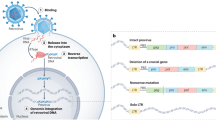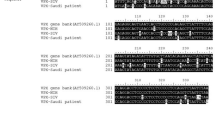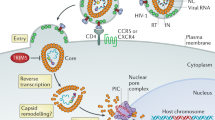Abstract
New human retroviruses antigenically related to HIV and even more closely to STLV-III have been recently isolated from individuals from some West African countries1–4. One of these viruses, HTLV-IVP, was reportedly isolated from lymphocytes of a healthy female prostitute1,2. Another isolate, LAV-2FG, was obtained from an AIDS patient and third, SBL-6669, from an individual with lymphadenopathy4. Current epidemiological studies indicate that some of these virus isolates cause immune deficiency whereas others may not or may be less efficient at inducing immune deficiency. Similarly, STLV-III apparently does not cause immune deficiency in its natural host, African green monkey5. A novel feature of HIV is the possession of a gene termed tat, which is implicated in its pathobiology6–12. We report here that, like HIV, HTLV-IVP, LAV-2FG (HIV-2) and SBL-6669, as well as STLV-IIIAGM possess the putative tat gene, irrespective of their pathogenic potential in vivo. Interestingly, HTLV-IVP/L A V-2FG long terminal repeat (LTR) is equally well transactivated by the HTLV-IVP/LAV-2FG and HTLV-IIIB tat function, HTLV-IIIB LTR responds better to its own tat function.
This is a preview of subscription content, access via your institution
Access options
Subscribe to this journal
Receive 51 print issues and online access
$199.00 per year
only $3.90 per issue
Buy this article
- Purchase on Springer Link
- Instant access to full article PDF
Prices may be subject to local taxes which are calculated during checkout
Similar content being viewed by others
References
1. Barin, F. et al. Lancet H, 1387–1390 (1985). 2. Kanki, P. J. et al. Science 232, 238–243 (1986). 3. Clowel, F. et al. Science 233, 343–346 (1986). 4. Albert, J. et al. J. AIDS Res. Human Retroviruses (in the press). 5. Kanki, P. J., Alroy, J. & Essex, M. Science 230, 951–954 (1985). 6. Arya, S. K. et al. Science 225, 927–930 (1984). 7. Sodroski, J. G. et al. Science 227, 171–173 (1985). 8. Arya, S. K., Guo, C, Josephs, S. F. & Wong–Staal, F. Science 229, 69–73 (1985). 9. Arya, S. K. & Gallo, R. C. Proc. natn. Acad. Sci. U.S.A. 83, 2209–2213 (1986). 10. Sodroski, J. G., Patarca, R., Rosen, C., Wong–Staal, F. & Haseltine, W. A. Science 229, 74–77 (1985). 11. Dayton, A. I., Sodroski, J. G., Rosen, C. A., Goh, W. C. & Haseltine, W. A. Cell 44,941–947 (1986). 12. Fisher, A. G. et al. Nature 320, 367–371 (1986). 13. Poiesz, B. J. et al. Proc. natn. Acad. Sci. U.S.A. 77, 7415–7419 (1980). 14. Miyoshi, I. et al. Nature 294, 770–771 (1981). 15. Popivic, M. et al. Nature 300, 63–66 (1982). 16. Yoshida, M., Miyshi, I. & Hinuma, Y. Proc. natn. Acad. Sci. U.S.A. 79, 2031–2035 (1982). 17. Wong–Staal, F. & Gallo, R. C. Nature 317, 395–403 (1985). 18. Gallo, R. C. in Cecil's Textbook of Medicine (eds Smith, L. H. & Wyngaarden, J. B.). 18th edn (Saunders, Philadelphia, in the press). 19. Kalyanaraman, V. S. et al. Science 218, 571–573 (1982). 20. Hahn, B. H. et al. Int. J. Cancer 34, 613–618 (1984). 21. Barre–Sinoussi, F. et al. Science 220, 868–871 (1983). 22. Popovic, N., Sarngadharan, M. G., Read, E. & Gallo, R. C. Science 224, 497–500 (1984). 23. Levy, J. A. et al. Science 225, 840–842 (1984). 24. Salahuddin, S. Z. et al. Proc. natn. Acad. Sci. U.S.A. 82, 5530–5534 (1985). 25. Clavel, F. et al. Nature 324, 691–695 (1986). 26. Kornfeld, H., Riedel, N., Viglianti, G. A., Hirsch, V. & Mullins, J. I. Nature 326, 610–613 (1987). 27. Guyader, M. et al. Nature 326, 662–669 (1987). 28. Murphy–Corb, M. et al. Nature 321, 435–437 (1986). 29. Kanki, P. J. et al. Science 228, 1199–1201 (1985). 30. Daniel, M. D. et al. Science 228, 1201–1204 (1985). 31. Alter, J. J. et al. Science 226, 549–552 (1984). 32. Yamamoto, N. et al. Med. microbiol. Immun. 173, 57–64 (1984). 33. Gorman, C. M., Moffat, L. F. & Howard, B. H. Molec. cell. Bio/. 2, 1044–1051 (1982). 34. Rosen, C. A., Sodroski, J. G. & Haseltine, W. A. Cell 41, 813–823 (1985). 35. Jones, K. A., Kadonaga, J. T., Luciw, P. A. & Tjian, R. Science 232, 755–758 (1986). 36. Muesing, M. A., Smith, D. H. & Capon, D. J. Cell 48, 691–701 (1987).
Author information
Authors and Affiliations
Rights and permissions
About this article
Cite this article
Arya, S., Beaver, B., Jagodzinski, L. et al. New human and simian HIV-related retroviruses possess functional transactivator (tat) gene. Nature 328, 548–550 (1987). https://doi.org/10.1038/328548a0
Received:
Accepted:
Issue Date:
DOI: https://doi.org/10.1038/328548a0
This article is cited by
-
Analysis of HIV-1 Tat effects inXenopus laevis embryos
Journal of Biomedical Science (1998)
-
Comparative studies ontat mutants of three primate lentiviruses
Archives of Virology (1990)
-
Comparison of simian immunodeficiency virus isolates
Nature (1988)
-
HIV-1 tat trans-activation requires the loop sequence within tar
Nature (1988)
Comments
By submitting a comment you agree to abide by our Terms and Community Guidelines. If you find something abusive or that does not comply with our terms or guidelines please flag it as inappropriate.



